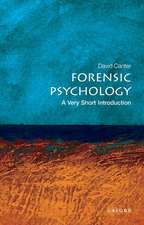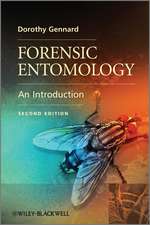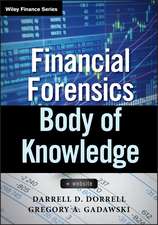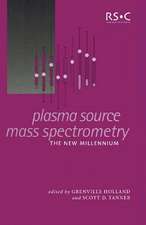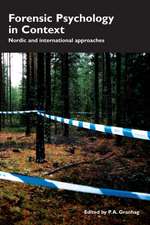Mass Spectrometry: A Textbook
Autor Jürgen H. Gross Cuvânt înainte de Peter Roepstorffen Limba Engleză Paperback – oct 2014
– New chapter on Tandem Mass Spectrometry covering instrumentation, methods for ion activation (CID, ECD, ETD, IRMPD), and applications
– New chapter on Ambient Mass Spectrometry (DART, DESI, and more)
– New chapter on Inorganic Mass Spectrometry including element speciation and imaging
– Learning Objectives for all chapters
– Advanced Instrumentation such as orbitraps, linear ion traps, tandem TOFs, FT-ICR and the highly variable hybrid instruments
– Updated Problems and Solutions website (www.ms-textbook.com)
Jürgen H. Gross provides in-depth explanations of concepts, methods, and techniques. Students and professionals alike are guided step-by-step from the basics to the successful application of mass spectrometry. Starting from the very principles of gas-phase ion chemistry, isotopic composition, and accurate mass, Jürgen H. Gross leads through the design of all types of mass analyzers and ionization methods to mass spectral interpretation and coupling techniques. His book offers a balanced mixture of practice-oriented information and theoretical background supported by a wealth of references.
From reviews of the previous edition:
“…one of the best textbooks on mass spectrometry I have seen so far.” International Journal of Mass Spectrometry
“…can be recommended unreservedly as a textbook and reference source…” Angewandte Chemie, International Edition
| Toate formatele și edițiile | Preț | Express |
|---|---|---|
| Paperback (2) | 528.69 lei 38-44 zile | |
| Springer International Publishing – aug 2018 | 528.69 lei 38-44 zile | |
| Springer Berlin, Heidelberg – oct 2014 | 663.93 lei 6-8 săpt. | |
| Hardback (1) | 707.83 lei 38-44 zile | |
| Springer International Publishing – 29 iun 2017 | 707.83 lei 38-44 zile |
Preț: 663.93 lei
Preț vechi: 781.08 lei
-15% Nou
Puncte Express: 996
Preț estimativ în valută:
127.06€ • 132.16$ • 104.89£
127.06€ • 132.16$ • 104.89£
Carte tipărită la comandă
Livrare economică 14-28 aprilie
Preluare comenzi: 021 569.72.76
Specificații
ISBN-13: 9783642423468
ISBN-10: 3642423469
Pagini: 780
Ilustrații: XXIV, 753 p.
Dimensiuni: 155 x 235 x 45 mm
Greutate: 1.07 kg
Ediția:2nd ed. 2011
Editura: Springer Berlin, Heidelberg
Colecția Springer
Locul publicării:Berlin, Heidelberg, Germany
ISBN-10: 3642423469
Pagini: 780
Ilustrații: XXIV, 753 p.
Dimensiuni: 155 x 235 x 45 mm
Greutate: 1.07 kg
Ediția:2nd ed. 2011
Editura: Springer Berlin, Heidelberg
Colecția Springer
Locul publicării:Berlin, Heidelberg, Germany
Public țintă
Upper undergraduateCuprins
Introduction.- Principles of Ionization and Ion Dissociation.- Isotopic Composition and Accurate Mass.- Instrumentation.- Practical Aspects of Electron Ionization.- Fragmentation of Organic Ions and Interpretation of EI Mass Spectra.- Chemical Ionization.- Field Ionization and Field Desorption.- Tandem Mass Spectrometry.- Fast Atom Bombardment.- Matrix-Assisted Laser Desorption/Ionization.- Electrospray Ionization.- Ambient Mass Spectrometry.- Hyphenated Methods.- Inorganic Mass Spectrometry.
Recenzii
From the reviews of the second edition:
“The expansive range of topics in mass spectrometry is well surveyed in this large volume. Gross … manages extraordinary breadth and adequate depth, delving into classical and current topics in theory, instrumentation, and applications. This work serves as a useful reference for those in the field … but also functions effectively as a textbook, with ‘Learning Objectives’ for each chapter and several appendixes outlining step-by-step approaches for students to solve problems. … Summing Up: Recommended. Upper-division undergraduates and above.” (E. J. Chang, Choice, Vol. 49 (3), November, 2011)
“Mass Spectrometry by Jürgen Gross is aimed at all mass spectrometrists and MS data users who practice their profession beyond routine and wish to better understand the basics and gimmicks of modern mass spectrometry. … gains a vivid impression of the innovative energy and creativity of the field. … a highly useful guide to the technical world of analytical mass spectrometry. It is unique, as it is a condensed source of numerous details that are rarely discussed at the expert level in one place.” (Wolf Dieter Lehmann, Analytical and Bioanalytical Chemistry, Vol. 401 (10), December, 2011)
“This is a serious and substantial textbook, which will be invaluable for established users of mass spectrometry wanting to revise their knowledge, as well as newcomers wishing to learn the subject from an historical and extremely thorough viewpoint. The text explains in detail, with excellent figures and photographs, the principles of mass spectrometry from ionisation techniques (starting with electron impact) through to instrumental designs (finishing with travelling wave stacked ring ion guides and orbitrap technologies).” (Alison Ashcroft, Chemistry World, December, 2011)
“While undergraduates might find the exemplary explanations of the many varieties of mass spectrometry helpful, this text is really aimed at researcherswho wish to better understand their equipment or look into alternative approaches for analysing samples. It is a fantastic reference guide, with many schematics and photographs of equipment. It also contains useful guides on how to search reference libraries. The layout is perfectly functional, and a detailed table of contents and index make the text a delight to use.” (Rebecca Ingle, The Times Higher Education, November, 2011)
“The expansive range of topics in mass spectrometry is well surveyed in this large volume. Gross … manages extraordinary breadth and adequate depth, delving into classical and current topics in theory, instrumentation, and applications. This work serves as a useful reference for those in the field … but also functions effectively as a textbook, with ‘Learning Objectives’ for each chapter and several appendixes outlining step-by-step approaches for students to solve problems. … Summing Up: Recommended. Upper-division undergraduates and above.” (E. J. Chang, Choice, Vol. 49 (3), November, 2011)
“Mass Spectrometry by Jürgen Gross is aimed at all mass spectrometrists and MS data users who practice their profession beyond routine and wish to better understand the basics and gimmicks of modern mass spectrometry. … gains a vivid impression of the innovative energy and creativity of the field. … a highly useful guide to the technical world of analytical mass spectrometry. It is unique, as it is a condensed source of numerous details that are rarely discussed at the expert level in one place.” (Wolf Dieter Lehmann, Analytical and Bioanalytical Chemistry, Vol. 401 (10), December, 2011)
“This is a serious and substantial textbook, which will be invaluable for established users of mass spectrometry wanting to revise their knowledge, as well as newcomers wishing to learn the subject from an historical and extremely thorough viewpoint. The text explains in detail, with excellent figures and photographs, the principles of mass spectrometry from ionisation techniques (starting with electron impact) through to instrumental designs (finishing with travelling wave stacked ring ion guides and orbitrap technologies).” (Alison Ashcroft, Chemistry World, December, 2011)
“While undergraduates might find the exemplary explanations of the many varieties of mass spectrometry helpful, this text is really aimed at researcherswho wish to better understand their equipment or look into alternative approaches for analysing samples. It is a fantastic reference guide, with many schematics and photographs of equipment. It also contains useful guides on how to search reference libraries. The layout is perfectly functional, and a detailed table of contents and index make the text a delight to use.” (Rebecca Ingle, The Times Higher Education, November, 2011)
Notă biografică
Jürgen H. Gross is head of the mass spectrometry facility at the Institute of Organic Chemistry of the University of Heidelberg, Germany
Textul de pe ultima copertă
This highly successful textbook, acclaimed for its comprehensiveness, accuracy, and its many excellent illustrations and photographs now comes in its second edition. Completely revised and substantially extended it offers:
– New chapter on Tandem Mass Spectrometry covering instrumentation, methods for ion activation (CID, ECD, ETD, IRMPD), and applications
– New chapter on Ambient Mass Spectrometry (DART, DESI, and more)
– New chapter on Inorganic Mass Spectrometry including element speciation and imaging
– Learning Objectives for all chapters
– Advanced Instrumentation such as orbitraps, linear ion traps, tandem TOFs, FT-ICR and the highly variable hybrid instruments
– Updated Problems and Solutions website (www.ms-textbook.com)
Jürgen H. Gross provides in-depth explanations of concepts, methods, and techniques. Students and professionals alike are guided step-by-step from the basics to the successful application of mass spectrometry. Starting from the very principles of gas-phase ion chemistry, isotopic composition, and accurate mass, Jürgen H. Gross leads through the design of all types of mass analyzers and ionization methods to mass spectral interpretation and coupling techniques. His book offers a balanced mixture of practice-oriented information and theoretical background supported by a wealth of references.
From reviews of the previous edition:
“…one of the best textbooks on mass spectrometry I have seen so far.” International Journal of Mass Spectrometry
“…can be recommended unreservedly as a textbook and reference source…” Angewandte Chemie, International Edition
– New chapter on Tandem Mass Spectrometry covering instrumentation, methods for ion activation (CID, ECD, ETD, IRMPD), and applications
– New chapter on Ambient Mass Spectrometry (DART, DESI, and more)
– New chapter on Inorganic Mass Spectrometry including element speciation and imaging
– Learning Objectives for all chapters
– Advanced Instrumentation such as orbitraps, linear ion traps, tandem TOFs, FT-ICR and the highly variable hybrid instruments
– Updated Problems and Solutions website (www.ms-textbook.com)
Jürgen H. Gross provides in-depth explanations of concepts, methods, and techniques. Students and professionals alike are guided step-by-step from the basics to the successful application of mass spectrometry. Starting from the very principles of gas-phase ion chemistry, isotopic composition, and accurate mass, Jürgen H. Gross leads through the design of all types of mass analyzers and ionization methods to mass spectral interpretation and coupling techniques. His book offers a balanced mixture of practice-oriented information and theoretical background supported by a wealth of references.
From reviews of the previous edition:
“…one of the best textbooks on mass spectrometry I have seen so far.” International Journal of Mass Spectrometry
“…can be recommended unreservedly as a textbook and reference source…” Angewandte Chemie, International Edition
Caracteristici
Comprehensive, precise, and excellently illustrated as ever, this new edition is completely revised and extended Three new chapters on tandem mass spectrometry, ambient mass spectrometry, and inorganic mass spectrometry added, bioanalytical applications extended Learning objectives for all chapters Includes supplementary material: sn.pub/extras

